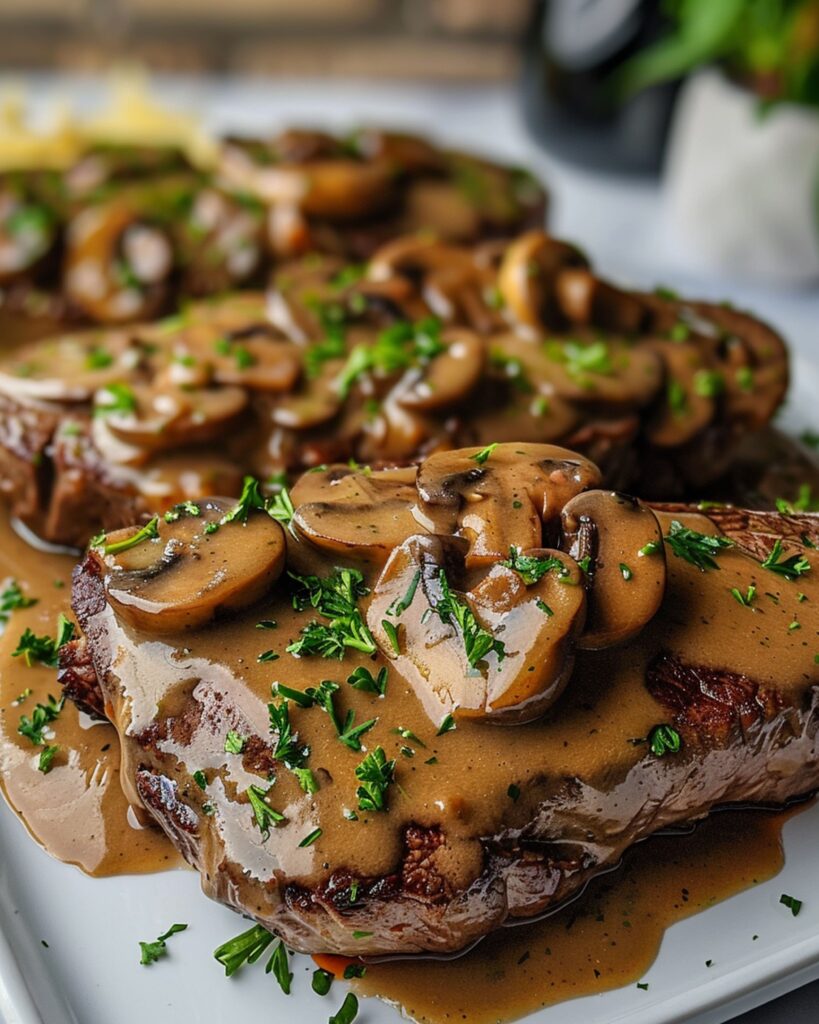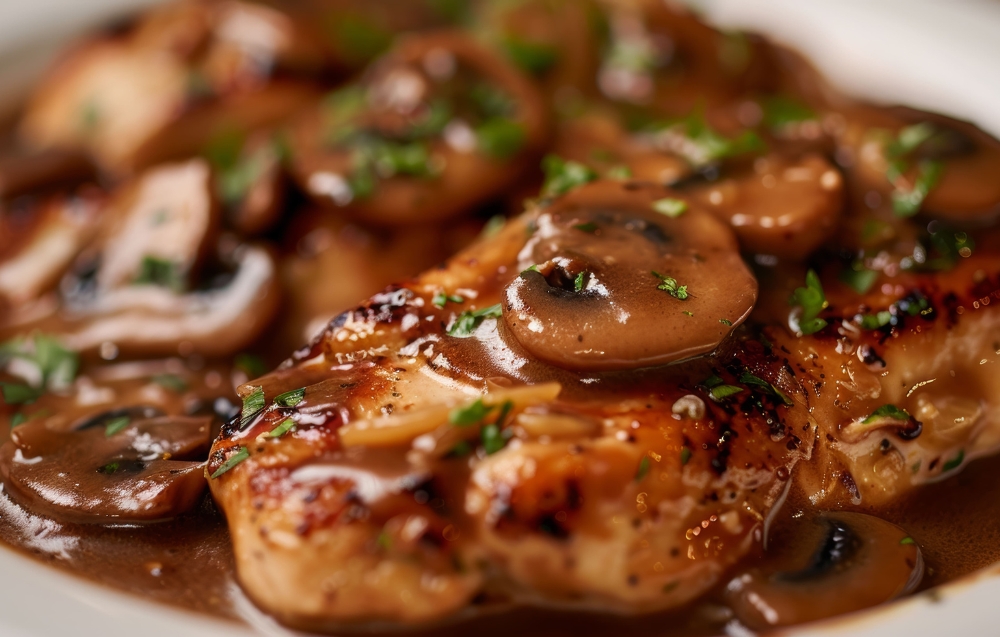When it comes to comfort food, few dishes hit the spot quite like Salisbury steak. This hearty, flavorful dish has been a staple on dinner tables for generations, and for good reason. It’s simple, satisfying, and packed with savory goodness. But what exactly goes into making the perfect Salisbury steak? What are the main ingredients that give it its signature taste and texture? And how can you avoid common pitfalls when preparing it? Let’s dive in and explore everything you need to know about the main ingredients in Salisbury steak, along with tips, tricks, and solutions to make your dish unforgettable.
Table of Contents
Introduction to Salisbury Steak
What Makes Salisbury Steak Unique?
Salisbury steak isn’t just a fancy name for a hamburger patty. Sure, it’s made with ground meat, but what sets it apart is the way it’s prepared and served. Unlike a burger, Salisbury steak is typically smothered in a rich, savory gravy that seeps into every bite, making it moist and bursting with flavor. It’s a dish that feels both rustic and refined, like something your grandma would make but with a touch of elegance.
The magic of Salisbury steak lies in its simplicity. It doesn’t require exotic ingredients or complicated techniques. Instead, it relies on a handful of key components that work together to create a dish that’s greater than the sum of its parts.
Salisbury Steak Recipe: Family Dinner Made Easy pairs perfectly with a side of Easy Steak Pasta for a comforting and complete meal.
The Origins and Evolution of Salisbury Steak
Believe it or not, Salisbury steak has been around since the late 19th century. It was named after Dr. James Salisbury, a physician who believed that a diet centered around ground beef could improve health and digestion. While his theories might sound a bit outdated today, his namesake dish has stood the test of time.
Originally, Salisbury steak was a simple patty made from ground beef, seasoned lightly, and served without gravy. Over the years, it evolved into the dish we know and love today, complete with onions, breadcrumbs, and that iconic gravy. It’s a testament to how food can adapt and grow, taking on new flavors and forms while staying true to its roots.
Discover how Banana Pepper: The Secret to Better Meals can elevate your Salisbury Steak Recipe: Family Dinner Made Easy with a tangy twist.
Why Salisbury Steak is a Timeless Dish
The Comfort Food Factor
Let’s be honest—there’s something deeply comforting about a plate of Salisbury steak. Maybe it’s the tender, juicy patty, or perhaps it’s the rich, velvety gravy that coats every bite. Whatever it is, this dish has a way of making you feel at home, no matter where you are.
Think about it: when you’re having a rough day, what do you crave? Probably not a fancy, five-course meal. You want something hearty, familiar, and satisfying. That’s where Salisbury steak comes in. It’s the culinary equivalent of your favorite cozy sweater—reliable, comforting, and always there when you need it.
Wondering Do Steak And Pasta Go Together? Try combining them in this Easy Steak Pasta dish for a delicious answer.
Versatility in Preparation and Serving
One of the best things about Salisbury steak is how versatile it is. You can dress it up or keep it simple, depending on your mood. Feeling fancy? Add a splash of red wine to the gravy or top it with sautéed mushrooms. Want to keep it classic? Stick to the basics and let the flavors speak for themselves.
And let’s not forget about the sides. Salisbury steak pairs beautifully with mashed potatoes, roasted vegetables, or even a simple green salad. It’s a dish that can adapt to any occasion, from a weeknight dinner to a special family gathering.

The Core Ingredients of Salisbury Steak
Ground Beef: The Foundation of Flavor
At the heart of every Salisbury steak is ground beef. It’s the star of the show, providing the dish with its rich, meaty flavor. But not all ground beef is created equal. For the best results, opt for ground beef with a slightly higher fat content, like 80/20. The fat adds moisture and flavor, ensuring that your patties stay juicy and tender.
If you’re feeling adventurous, you can even mix different types of ground meat. A combination of beef and pork, for example, can add depth and complexity to the flavor. Just remember to keep the beef as the main ingredient to stay true to the classic Salisbury steak experience.
Add a sprinkle of Feta Cheese Nutrition to your steak: The Secret to Better Meals for a creamy and healthy flavor boost.
Breadcrumbs: The Key to Texture
Breadcrumbs might seem like a small detail, but they play a crucial role in Salisbury steak. They act as a binding agent, helping to hold the patties together and prevent them from falling apart during cooking. But they also add texture, giving the steak a slight crunch that contrasts beautifully with the tender meat.
You can use plain breadcrumbs or seasoned ones, depending on your preference. If you’re looking for a gluten-free option, almond flour or crushed gluten-free crackers can work just as well.
Eggs: The Binding Powerhouse
Eggs are another essential ingredient in Salisbury steak. They act as a glue, binding the meat, breadcrumbs, and seasonings together to form a cohesive patty. Without eggs, your Salisbury steak might end up crumbly and dry.
When adding eggs to your mixture, be sure to beat them lightly first. This ensures that they’re evenly distributed throughout the meat, helping to create a uniform texture.
Onions: A Flavorful Essential
Onions are a must-have ingredient in Salisbury steak. They add a subtle sweetness and depth of flavor that complements the beef perfectly. You can use yellow onions for a milder taste or red onions for a bit more bite.
To incorporate onions into your mixture, finely chop or grate them. This ensures that they blend seamlessly into the meat, adding flavor without overwhelming the dish.
Seasonings: Salt, Pepper, and More
Seasonings are where you can really make Salisbury steak your own. At a minimum, you’ll want to use salt and pepper to enhance the natural flavors of the beef. But don’t stop there! Garlic powder, onion powder, and paprika can add depth and complexity, while a pinch of cayenne pepper can give the dish a subtle kick.
“Seasoning is the soul of any dish. Don’t be afraid to experiment and find what works best for you.” – Chef’s Wisdom
The key is to taste as you go. Start with a small amount of seasoning, mix it into the meat, and adjust as needed. Remember, you can always add more, but you can’t take it away.
Worcestershire Sauce: The Flavor Enhancer
Worcestershire sauce is the secret weapon in many savory dishes, and Salisbury steak is no exception. This tangy, umami-rich sauce adds depth and complexity to the meat, elevating it from good to great.
A little goes a long way, so start with a tablespoon or two and adjust to taste. If you don’t have Worcestershire sauce on hand, soy sauce or balsamic vinegar can work as a substitute, though the flavor will be slightly different.
Milk or Broth: Keeping It Moist and Tender
Last but not least, milk or broth is essential for keeping your Salisbury steak moist and tender. The liquid helps to soften the breadcrumbs and bind the ingredients together, creating a patty that’s juicy and flavorful.
You can use any type of milk—dairy or non-dairy—depending on your preference. Broth, whether beef or vegetable, adds an extra layer of flavor and works just as well.
Unlock the secrets to perfect seasoning and elevate your Salisbury steak to the next level.
Exploring Variations of Salisbury Steak Ingredients
Using Ground Turkey or Chicken for a Lighter Option
If you’re looking to lighten up your Salisbury steak, ground turkey or chicken can be excellent alternatives to beef. These leaner meats still provide plenty of flavor, especially when paired with the right seasonings and gravy. Ground turkey, in particular, has a mild taste that absorbs the flavors of Worcestershire sauce, onions, and spices beautifully. Just keep in mind that leaner meats can dry out faster, so adding a bit of extra moisture, like broth or a splash of olive oil, can help keep your patties tender.
Gluten-Free and Low-Carb Alternatives
For those following a gluten-free or low-carb diet, Salisbury steak is still on the menu! Instead of traditional breadcrumbs, try using almond flour, crushed pork rinds, or even grated Parmesan cheese as a binder. These alternatives not only keep the dish gluten-free but also add a unique flavor and texture. If you’re avoiding carbs altogether, skip the breadcrumbs entirely and rely on eggs and finely chopped vegetables to hold the patties together.
Adding Herbs and Spices for a Unique Twist
While the classic Salisbury steak recipe is delicious on its own, don’t be afraid to experiment with herbs and spices to make it your own. Fresh herbs like thyme, rosemary, or parsley can add a burst of freshness, while spices like smoked paprika or cumin can give the dish a smoky or earthy twist. If you’re feeling adventurous, a pinch of chili powder or a dash of hot sauce can bring a subtle heat that elevates the entire dish.
The Importance of Gravy in Salisbury Steak
Traditional Gravy Ingredients
The gravy is what truly sets Salisbury steak apart from other ground meat dishes. A classic Salisbury steak gravy is made with a base of pan drippings, beef broth, and a thickening agent like flour or cornstarch. Onions, garlic, and Worcestershire sauce are often added for extra flavor, creating a rich, savory sauce that complements the meat perfectly.
How to Make Rich and Flavorful Gravy
Making gravy might seem intimidating, but it’s actually quite simple. Start by using the same pan you cooked the patties in to capture all the flavorful bits left behind. Add a bit of butter or oil, then whisk in flour to create a roux. Slowly pour in beef broth, stirring constantly to avoid lumps. Let the gravy simmer until it thickens, then season with salt, pepper, and a splash of Worcestershire sauce. The result? A velvety, flavorful gravy that ties the whole dish together.
Common Gravy Mistakes and How to Solve Them
Even the best cooks can run into issues when making gravy. One common problem is lumps, which can form if the flour isn’t whisked smoothly into the broth. To fix this, strain the gravy through a fine mesh sieve before serving. Another issue is a gravy that’s too thin. If this happens, mix a small amount of cornstarch with cold water and stir it into the gravy, then simmer until it thickens. On the flip side, if your gravy is too thick, simply add a bit more broth or water to reach your desired consistency.
Step-by-Step Guide to Making Salisbury Steak
Step 1: Preparing the Meat Mixture
The first step in making Salisbury steak is preparing the meat mixture. Start by combining your ground beef (or alternative meat) with finely chopped onions, breadcrumbs, beaten eggs, and your chosen seasonings. Don’t forget a splash of Worcestershire sauce for that umami kick! Mix everything together gently—overworking the meat can make the patties tough. Think of it like folding ingredients into a cake batter; you want everything evenly distributed without squishing the life out of it.
Pro tip: If you’re unsure about the seasoning, cook a small piece of the mixture in a pan and taste it. This way, you can adjust the flavors before shaping the patties.
Step 2: Shaping the Patties
Once your mixture is ready, it’s time to shape the patties. Divide the mixture into equal portions—usually about 4 to 6, depending on how big you want your steaks. Shape them into oval patties, about ¾-inch thick. Why oval? It’s traditional, but honestly, round works just fine if you’re not fussy about aesthetics.
To prevent the patties from cracking while cooking, use your thumb to make a slight indentation in the center of each one. This helps them cook evenly and stay flat instead of puffing up in the middle.
Step 3: Cooking the Patties to Perfection
Now comes the fun part—cooking the patties! Heat a large skillet over medium heat and add a bit of oil or butter. Once the pan is hot, carefully place the patties in the skillet. Let them cook undisturbed for about 4-5 minutes on each side, or until they develop a nice golden-brown crust. Don’t overcrowd the pan; cook in batches if necessary.
Resist the urge to press down on the patties with a spatula—this squeezes out the juices and leaves you with dry, sad steaks. Instead, let them do their thing. Once they’re browned on both sides, remove them from the pan and set them aside. They don’t need to be fully cooked at this stage because they’ll finish cooking in the gravy later.
Step 4: Preparing the Gravy
With the patties resting, it’s time to make the gravy. In the same skillet (don’t wash it—those browned bits are flavor gold!), add a bit more butter or oil if needed. Toss in some finely chopped onions and garlic, and sauté until they’re soft and fragrant. Sprinkle in a couple of tablespoons of flour and stir to create a roux. This will thicken your gravy and give it a silky texture.
Slowly pour in beef broth, whisking constantly to avoid lumps. Bring the mixture to a simmer, and let it thicken. Add a splash of Worcestershire sauce, a pinch of salt, and a grind of black pepper. Taste and adjust the seasoning as needed. If you’re feeling fancy, you can add a splash of cream or a pat of butter at the end for extra richness.
Step 5: Combining Everything for the Final Dish
Once your gravy is ready, return the patties to the skillet, nestling them into the sauce. Let everything simmer together for about 10 minutes, allowing the flavors to meld and the patties to finish cooking. This step is crucial—it’s where the magic happens. The patties soak up the gravy, becoming even more tender and flavorful.
Common Problems When Making Salisbury Steak
Problem: The Steak Falls Apart During Cooking
This is a common issue, especially if you skip the binding agents like eggs or breadcrumbs. If your patties are crumbling, it’s likely because the mixture wasn’t cohesive enough.
Solution: Make sure you’re using enough eggs and breadcrumbs to bind the meat. If the mixture feels too dry, add a splash of milk or broth to help everything stick together. Also, handle the patties gently when shaping and flipping them.
Problem: The Steak is Too Dry
Dry Salisbury steak is a tragedy, but it’s often caused by overcooking or using meat that’s too lean.
Solution: Use ground beef with a bit of fat (80/20 is ideal) to keep the patties juicy. Avoid overcooking—remember, the patties will finish cooking in the gravy. If you’re using a leaner meat like turkey or chicken, add extra moisture to the mixture, such as broth or grated zucchini.
Problem: The Flavor is Bland
If your Salisbury steak tastes a bit “meh,” it’s probably under-seasoned. Ground meat needs a generous hand with salt and spices to shine.
Solution: Don’t be shy with the seasonings! Taste the meat mixture before shaping the patties and adjust as needed. Worcestershire sauce, garlic powder, and smoked paprika are all great flavor boosters. And don’t forget to season the gravy well—it’s the backbone of the dish.
Healthier Alternatives for Salisbury Steak
Using Lean Ground Beef or Turkey
If you’re watching your fat intake, lean ground beef or ground turkey are excellent options. Just keep in mind that leaner meats can dry out more easily, so you’ll need to add extra moisture to the mixture. A splash of broth, a grated onion, or even a tablespoon of olive oil can help keep the patties tender.
Gluten-Free Breadcrumbs for a Healthier Option
For a gluten-free version, swap out traditional breadcrumbs for almond flour, crushed gluten-free crackers, or even rolled oats. These alternatives not only make the dish gluten-free but also add a unique texture and flavor.
Low-Sodium Gravy for a Heart-Healthy Twist
If you’re watching your sodium intake, you can make a lower-sodium gravy by using low-sodium beef broth and cutting back on added salt. Enhance the flavor with fresh herbs, garlic, and a splash of balsamic vinegar instead.
Pairing Salisbury Steak with Sides
Classic Mashed Potatoes: The Perfect Companion
Mashed potatoes and Salisbury steak are a match made in comfort food heaven. The creamy potatoes soak up the gravy, creating the ultimate bite. Add a pat of butter and a sprinkle of chives for extra indulgence.
Steamed Vegetables: Adding a Healthy Touch
For a lighter option, serve your Salisbury steak with a side of steamed vegetables like green beans, broccoli, or carrots. The fresh, crisp veggies balance out the richness of the dish.
Buttered Noodles: A Comforting Side Dish
Buttered egg noodles are another classic pairing. They’re simple, quick to make, and the perfect vehicle for that delicious gravy.

